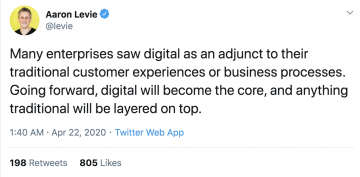 It’s both hard and easy to believe that the sentiment “Digital will become the core” still attracts a lot of attention in 2020. It’s hard to believe: Isn’t that the pivot we have all been making for more than twenty years? But it’s easy to believe when we experience interactions with enterprise companies that are mired in literal paperwork and cumbersome processes that clearly require a digital rethink.
It’s both hard and easy to believe that the sentiment “Digital will become the core” still attracts a lot of attention in 2020. It’s hard to believe: Isn’t that the pivot we have all been making for more than twenty years? But it’s easy to believe when we experience interactions with enterprise companies that are mired in literal paperwork and cumbersome processes that clearly require a digital rethink.
COVID will be a catalyst for the companies who have been holding back fully integrating digital initiatives into core operations. Rapid shifts in consumer behavior and heightened expectations created by organizations who are digital leaders will put pressure on the laggards to advance. Three examples of the kinds of changes playing out today:
- Distance or remote learning will dominate. Higher education is in the midst of a major transition to online learning: a little later than Clayton Christensen predicted, but with devastating effect. This shift translates into learning and credentialing for employees, where everything from new employee onboarding to advanced product training will take place online with in-person as the exception. Rather than forming separate divisions of online learning, learning software and expertise will be required everywhere from HR to Marketing Operations. There’s potentially huge upside here for companies to better identify and understand the verifiable skills in its employee base.
- Anything that can be sold online, will be sold online. We’ve seen online viewing rooms for art sales, virtual house tours for residential real estate, and of course the mass migration of thousands of Americans to buying their groceries online. Many of these new consumer habits will stick, and require enterprises still siloing their digital experience teams and customer data to shift them to the core. In many cases, the traditional experience will also need a complete rethink — for the times you will go to a physical grocery store, what should the new product layout look like? In a time where supply chains are, for now, intermittently disrupted, how might digital be used to signal availability of goods?
- Healthcare needs to deliver digital consistently. The term “telemedicine” has been around for decades, but until very recently it was a grudging exception to the in-person visit. Appointment scheduling and prescription refills have shifted online, but the digital patient experience is disjointed. At my own healthcare provider, for example, you can schedule visits with physicians you have seen through an app, but not new visits. Until very recently, many insurance companies refused to cover the video visits healthcare providers were actively promoting. These gaps in digital experience were felt by the consumer, and reflected the internal disconnect between different components of healthcare industry embracing digital at different speeds. Consumers will be reluctant to return to long telephone wait times and in-person visits where video would suffice, so real collaboration will be required to deliver digital in a heavily regulated industry.
Nothing about moving digital to the core is easy, particularly for enterprises with robust analog businesses slower to be disrupted. The COVID crisis shifts the equation dramatically:
- Pressure from customers and consumers for digital-first experiences accelerates
- Executive leadership / divisional silos reduce in the rush to adapt and serve the customer
- Employees working from home drive rapid adoption of collaboration software (and disrupt long evaluation periods / cost:benefit analyses led by IT)
- Tolerance for the kinds of quick experimentation that informs digital strategy is higher
The never waste a crisis rule applies here: for the enterprise organizations still operating with digital as an adjunct, it’s time to align data, technology, and culture to move digital to the core.
